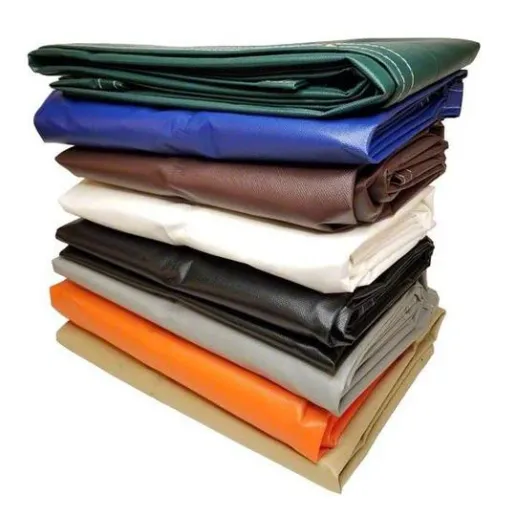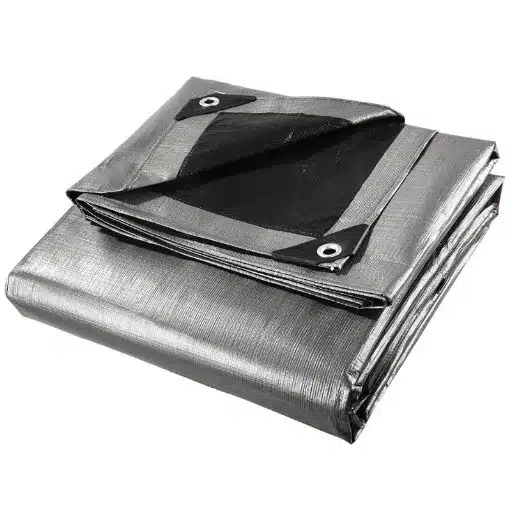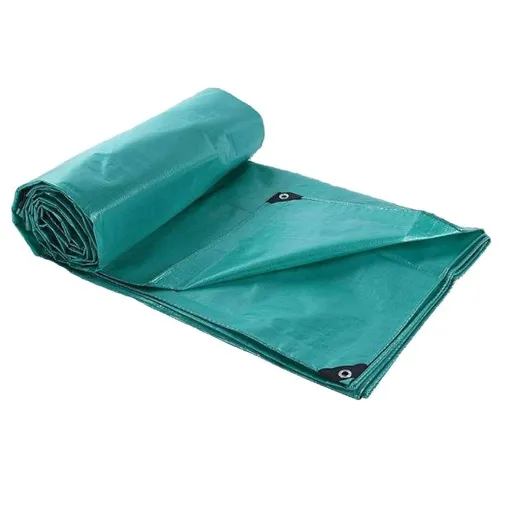An incorrect material underlay beneath swimming pool installation can be at times neglected yet greatly influencing the lifespan of the pool and your overall experience. Ground cloths for pools and tarps seem to be the options; what is your take? Each has its own pros and cons, while the main factors that steer this decision are durability, cost, and the extent of protection you wish to have. Going by this, this article delves into the difference between a ground cloth and a tarp for you to arrive at an informed decision so that your pool set-up remains strong and free from bother. Read along and see which one is right for your swimming pool!
Understanding Pool Ground Cloth and Tarps
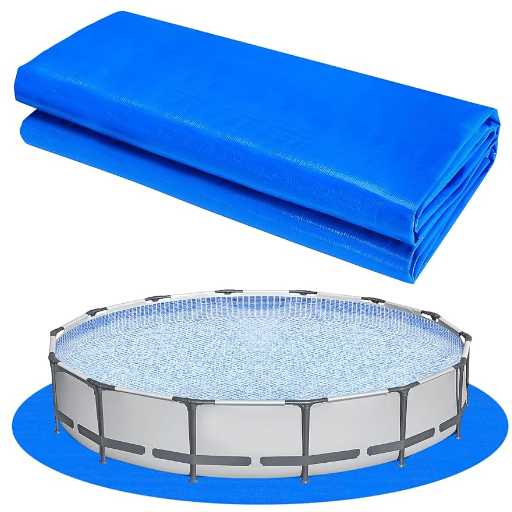
Pool Ground Cloth Defined
A pool ground cloth constitutes a layer of protection placed under the swimming pool to protect the base against aging. Usually, they are made of tough materials-CD polyester or polypropylene. A ground cloth poses as a barrier between your pool liner and the earth, preventing punctures, scratches, and moisture damage. Unlike regular tarps, these cloths are typically manufactured to suit different pool configurations and sizes to ensure total coverage with a snug fit. This certain ground cloth arrangement helps the pool finalization and gives a clean foundation with lesser chances of debris or sharp objects entering and damaging the pool.
What is a Tarp?
A tarp, short for tarpaulin, is a large flexible sheet, made of durable merchandises like polyethylene, canvas, or vinyl, generally reinforced for additional strength. Tarps are meant to shield against rain, winds, or sunlight. They come in various sizes and thicknesses with different kinds depending on their usage, such as covering outdoor equipment, creating shelter, or laying on the ground as surface protection.
With modern manufacturing, tarps are waterproof, UV-resistant, or tear-resistant, promising another day of life for them. Some even have grommets along the edges, so they can be fastened with ropes or stakes to hold them in place. They are of great utility; hence, tarps would be found handy for camping, construction, and just-any-other-day out.
Key Differences Between Ground Cloth and Tarps
Durability and Protection
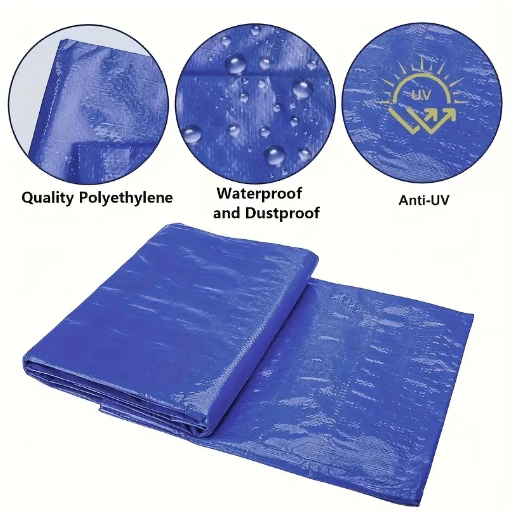
🛡️ How Ground Cloth Protects Pool Liners
The ground cloth acts as a protective barrier between the liner and the rough surface below. Current-day wisdom maintains that the ground cloth protects the pool liner against punctures from piercing objects such as stones, roots, or debris that may litter the ground. Thanks to ground cloth, the pool liners are protected from moisture and friction on the face of concrete initially, thereby reducing wear over time. The ground cloth improves the stability of the pool base and simultaneously results in a smoother installation with lesser chances of misalignments or wrinkles in the liner. Being lightweight yet strong, the ground cloth stands out as an apt investment for retaining the structural integrity and performance of pool liners.
⚡ How Effective Are Tarps for Ground Swimming Pools?
They can become an effective alternative for the traditional approach of having a ground cloth if of good quality and thickness. According to recent search data, heavy-duty tarps are becoming more popular, constructed from polyethylene or vinyl since they do not absorb water and resist tearing. Such tarps become reliable barriers stopping debris, moisture, or any form of sharp objects from entering the pool liner. Additionally, their wide range of sizes only adds to their flexibility, along with affordability as their cheapest option for pool owners. Be sure that they are anchored properly and remain wrinkle-free during installation, as the appearance of such problems can lead to the worse cases of uneven sheet surface and even movement of the sheet. For best results, ensure that the tarp used is one with high durability, manufactured specifically for outdoor use.
Weather-Resisting Properties: Ground Cloth vs Tarp
In the matter of weather resistance, several aspects are considered in the debate between a ground cloth and a tarp. A ground cloth is made of some tough and durable materials like vinyl or polyester and has always been designed to provide a strong barrier against moisture and also against rough surfaces. These cloths protect the pool against sharp objects on-the-go and against prolonged exposure to damp ground.
Tarps, generally, are made from polyethylene or canvas and are good at keeping the pool dry from rain, keeping dirt out, and protecting it from sun rays. However, in a condition of prolonged exposure to severe weather, tarps tend to wear quicker in comparison with ground cloths unless they are in the premium category.
📊 Market Insight: Heavy-duty tarps with UV protection and reinforced edges are among the most searched items in recent trend analysis data, reflecting increased awareness of enhanced weather resistance levels. Dark ground cloths with excellent weather resistance combined with tarps would be the best combination for realizing strength that aids the protection of the pool in every circumstance.
Cost-Effectiveness and Value
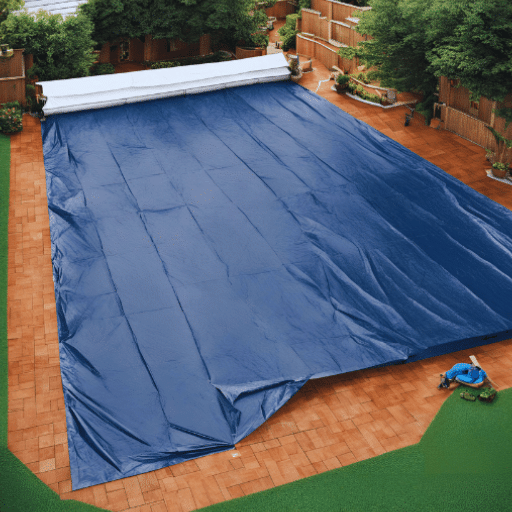
Initial Costs of Pool Ground Cloths and Tarps
Initial cost considerations of pool ground cloths and tarps must therefore be assessed in regard to their separate costs versus the added value when bought together. Generally, pool ground cloths are priced somewhere between $20 and $100, depending on the size, material used, or brand. Tarps, by contrast, could be much more of a variable: standard tarps start at $25, and heavy-duty ones go past $150, depending on UV protection and whatnot.
💰 Cost Breakdown:
- Pool Ground Cloths: $20 – $100 (varies by size, material, brand)
- Standard Tarps: Starting at $25
- Heavy-Duty Tarps: $150+ (with UV protection and enhanced features)
- Combined systems offer economical and practical solutions against future replacement costs
Long-Term Value: Maintenance and Lifespan
Maintaining heavy-duty tarps in combination with pool ground cloths makes it quite evident that the proper care of these materials promotes longevity. The newest search data reveals that amongst the most asked questions is, “How do you extend the life of your tarp?” There are a few things one can do.
🔧 Maintenance Best Practices:
- Clean tarps regularly to get dirt, debris, and mold off
- Store in dry, shaded areas from UV exposure and moisture when not in use
- Apply proper weight and stress distribution to enhance material durability
- Conduct routine inspections to detect early tears or weaknesses
- Choose UV-resistant and waterproof materials for complete protection framework
The Bottom Line from a Pool Owner’s Perspective
When planning a pool or maintaining the same, budgeting takes into consideration a crucial factor to keep it sustainable and affordable in the long run. According to recent data based on search engine queries, many pool owners ask questions regarding this initial upfront versus long-term costing. Installation provides variation according to the pool type: inground, above ground, or natural pools and prices usually range anywhere between $5,000 and $50,000-$100,000 or even more.
Recalling the installation, there are periodic expenses of water, electricity for the pumps and filtration systems, heating, and maintenance in the pool. In addition, the installation of energy-efficient devices such as variable-speed pumps or solar water heaters will enable householders to enjoy lower utility bills in the long term, with the search trends reinforcing the demand for greater sustainability.
Additional costs that owners may want to consider include pool covers to protect the pool, chemical treatments to maintain water quality, and repairs. Upon considering these factors through the lens of demand and data, owners can adequately prepare their pool to retain functionality and enjoyment for the family, thereby avoiding unexpected financial shocks.
Installation and Ease of Use
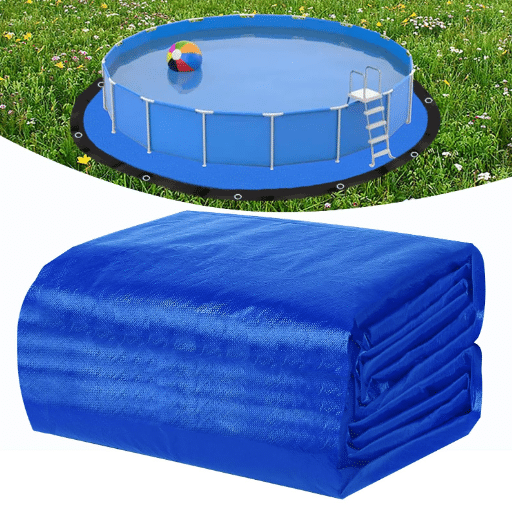
How to Install a Pool Ground Cloth
📋 Step-by-Step Installation Guide
Follow these essential steps for proper ground cloth installation
A pool ground cloth’s installation is done to keep the liner safe and make it last longer. From recent search trends, one can ascertain that users want these instructions simplified so they may be able to work with less errors and save time. Here is a step-by-step guide that will help in the correct installation of a pool ground cloth:
Prepare the Area
The place chosen for the pool installation should be flat and level with no rocks, branches, or sharp objects that could damage the pool liner. Online search queries indicate that inappropriate preparation of the site is the most missed step of all till maintenance time arrives.
Measure and Position
Unfold the pool ground cloth and place it over the ground area. Ensure that the cloth is large enough to provide coverage for the entire base of the pool themselves and perhaps will roll over a few inches around for the entire pool’s base. Many search queries suggest there is concern with reference to sizing of the cloth-so check and recheck your measurements before moving ahead.
Remove Wrinkles
The material must be laid out flat with no wrinkling or folding that brings in an uneven surface under your pool. Should there be any winds capable of lifting it, the ground cloth must be affixed to the ground by any means possible, such as with stakes and weights.
Set Pool on Cloth
Once you get the ground cloth laid flat, just take your time positioning the pool so that the base is centered exactly on the cloth. Many users say that misaligning the cloth is generally one of the main reasons it gets damaged during use, which defeats the purpose of putting this protective barrier there in the first place.
Following these steps and paying heed to the pitfalls outlined by search trends can ensure proper installation of your pool ground cloth. There’s no doubt the measure would add a layer of protection to the investment and serve well to increase its longevity.
Pool Tarp: A Step-By-Step Approach
Setting a tarp down as a protective base for your pool is not only cheap but also one of the most searched topics among pool owners, according to the latest data. One of the frequently asked questions is: “Can a tarp replace a traditional pool ground cloth?”
Answer: In short, yes, but with certain considerations. Tarps can act as a cheap and versatile alternative, giving protection against sharp objects such as rocks or sticks that could pierce the pool liner. On the other hand, tarps would rarely guarantee durability and precise fit for long-term use, unlike purpose-designed pool ground cloths.
🎯 Best Results Tips:
- Choose a tarp thick enough for your application
- Secure it tightly during installation
- Ensure it extends beyond the pool edges for adequate cover
- Proper site preparation is essential for best results
Comparing Installation Time and Effort
Choosing the Right Option for Your Pool
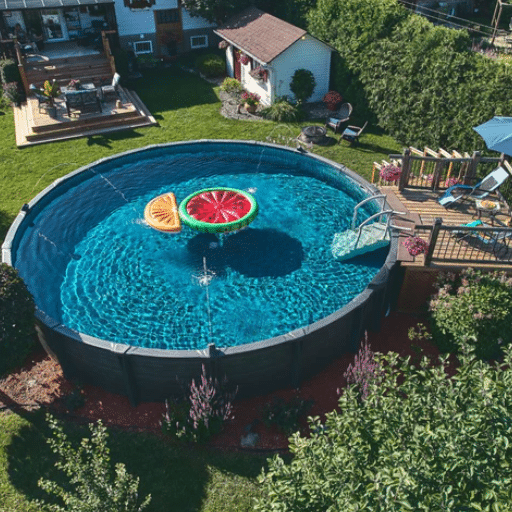
Factors to Consider When Selecting a Ground Cloth or Tarp
🏗️ Durability and Material Quality
Good materials, like reinforced polyethylene or PVC, are good against any wear and tear resulting from the heavy weight of the pool, hard terrain, or at times, moisture and ultraviolet rays. A good ground cloth or tarp, made from sturdy materials, goes a long way in ensuring durability.
📏 Size and Dimension
The ground cloth or tarp must match the size of your pool. It would be better if the layer went over the pool just a little bit, so there is enough protection over the edges. Taking good measurements helps to ease the installation procedure and cut down on wrinkles, which can cause bumps.
💰 Cost and Budget
Cost-wise, ground cloths are usually cheaper than heavy-duty tarps; in general, however, the latter may promise greater durability and utility. Therefore, determine the budget and, considering the price, decide if it corresponds to the level of protection required.
🔧 Installation Ease
Ground cloths are usually quicker to set up because of their specified sizes and lightness. Tarps must be adjusted and fastened more; hence they can be designed for a wider array of applications that provide versatility.
🌦️ Environmental Conditions
Evaluate the environment in which your pool will be set up. For regions with constant moisture, muddy ground, or harsh UV exposure, opt for tarps that have water and UV resistive coatings. Whereas in milder conditions, a standard ground cloth shall suffice.
Tarps for Given Pools
What works best for your pool tarp depends on what is specific for the needs and circumstances experienced by your pool. Here are some recommendations for different pools:
🏊 Above-Ground Pools
Heavy-duty polyethylene tarps would be the best. These tarps do not allow for any amount of water to pass through, are durable, and protect your pool from debris, leaves, and even small animals. Look for tarps that have a UV coating to prevent harm from the sun and are made out of tear-resistant design for long utilization.
🎈 Inflatable Pools
Light, yet hard-wearing tarps are best for inflatable pools. Medium-weight tarps will withstand sharp objects on the grounds with liquid protection to prevent punctures from above. Reinforced grommets along the edges may further help keep the tarp secure in strong winds.
🏊♂️ Large In-Ground Pools
Large sizes of tarps or pool covers custom-made to fit actual measurements and shapes of large in-ground pools. Mesh safety tarps keep debris out and prevent water from accumulating on the tarp finish. If one is located within a heavy snow region, a solid winter tarp of maximum tensile strength should be a choice.
👶 Kiddie Pools
Smaller kiddie pools can use very basic lightweight tarps to keep the water clean while not in use. Breathable fabric tarps are also an alternative; however, these minimize moisture buildup while also effectively blocking dirt and dust.
🧂 Saltwater Pools
Being exposed to salt necessitates corrosion-resistant materials to be incorporated in tarp construction for saltwater pools. Heavy-duty vinyl tarps are another very common choice and fare well against salt exposure.
On selecting a tarp customized by pool kind, one may prolong the life of a pool, keep the water clean for bathing, and safeguard it from other environmental elements that might interfere with an ideal bathing experience.
Expert Perspective and User Opinions
A confluence of expert insight methodically infused with recent data search trends brings a realization that pool owners consider durability, ease of use, and justifying the pricing as key qualities of a pool tarp. Users almost always emphasize the need to select a material based on their climatic conditions and pool type because performance and durability of a tarp are highly dependent on these conditions.
For example, in heavy seasonal snow areas, owners would use tarps with extra reinforcement of polyester or polyethylene, whereas UV resistance options would be selected in sunnier regions. Experts also stressed maintenance, such as cleaning debris off the tarp and checking it for wear, to enhance its effectiveness and longevity.
💡 Key Insights:
- Reviews from users stress the importance of buying good quality tarps
- Cheap tarps tend to require frequent replacement, costing more long-term
- Climate and pool type are critical factors in material selection
- Combining professional recommendations with user experiences ensures wise choices
Frequently Asked Questions
❓ What makes a pool ground cloth any different from a pool tarp?
In contrast with a tarp that can be used for a variety of purposes, a ground cloth is a) an underlining for swimming pools and, b) provides smooth and puncture-resistant surfaces for protecting pool bottoms from sharps and enhancing stability. Poly tarps, although water-resistant and temporary covers, may not offer the same durability and UV resistance as a pool ground cloth. Choosing between the two options for pool setup may never be an easy decision, as it prolongs the pool’s life and makes maintenance easier. Ultimately, while both serve a protective role, the benefits and applications of these products differ significantly.
❓ How do I decide on a tarp or ground cloth for my pool set up?
The size, material, and intended use of the tarp or ground cloth are key factors to consider. A tough polyethylene tarp may act in a rugged way but may fail to provide protection afforded by a ground cloth, which is made to take the conditions underneath a pool. In addition, ensure that the tarp or ground cloth covers the entire bottom of your pool with sufficient ground cover. For an above-ground pool, a ground cloth can level the ground and protect it from punctures, while a tarp may be better suited for a temporary application. Always choose products that claim UV resistance and water-proofing for proper maintenance of your pool area.
❓ Would a normal tarp behave as well as a heavy-duty tarp in my pool?
The use of any tarp cheaper than a heavy PVC for pool applications is generally not recommended. The regular tarp cannot be able to withstand all kinds of rigor and acts as a better sack to the bottom of the pool in case of sharp objects being present. The heavier the tarp, such as heavy-grade polyethylene tarpaulin, the tougher will be the surface it can hold against corrosion. Hence, a heavy tarp or pool ground cloth will pay for itself in the long run when you are thinking about covering your pool or laying the ground surface. Always stick to materials that repel water and contain UV ray protection for the best in pool care.
❓ What makes heavy-duty poly tarp the preferred option in pool maintenance?
Standard poly tarps provide a whole bunch of benefits for pool maintenance, including superior durability and resistance against tearing and puncturing. It can be used as a cover when the pool is not in use to ensure that debris does not enter, or as a ground cover to keep the bottom clean during setup. These tarps are usually water-resistant; they keep water from accumulating and hence forming mold and algae. When selecting a tarp for pool maintenance, ensure that you select the right size tarp-the entire pool area must be covered with the tarp-and also consider tarp materials that provide UV resistance as extra protection against direct sunlight. Overall, heavy-duty tarps will greatly increase the lifetime of your pool and lessen maintenance efforts.
❓ Is it possible to use a tarp as a cover for a swimming pool?
The very act of covering the pool with a tarp is possible; however, it hardly offers the protection as does a pool cover. A tarp stops debris and sunlight from entering a pool, but it usually lacks a good fit and sealing capabilities that a pool cover affords. If using a tarp, choose the heavy-duty, waterproof kind that will withstand the elements. The tarp must be secured well to avoid being blown away or allowing debris to blow into the pool. Though tarps can be considered temporary pool covers, a good-quality pool cover would be easier to work with and afford better protection.
Reference Sources
- Imperial Valley College – Bestway Fast Set Pool Instructions:
Provides guidance on using a tarp or ground cloth to protect pool liners from punctures and for setting up pools on uneven ground.Link to source - Piedmont Virginia Community College – Staff Handbook of Good Housekeeping and Pollution Prevention:
Discusses the use of tarps, ground cloths, and other protective measures for outdoor activities to prevent damage and spills.Link to source - City of Tacoma – Surface Water Management Manual:
Mentions the use of ground cloths, tarps, and other protective devices for various outdoor applications, including tool cleaning and spill prevention.Link to source

